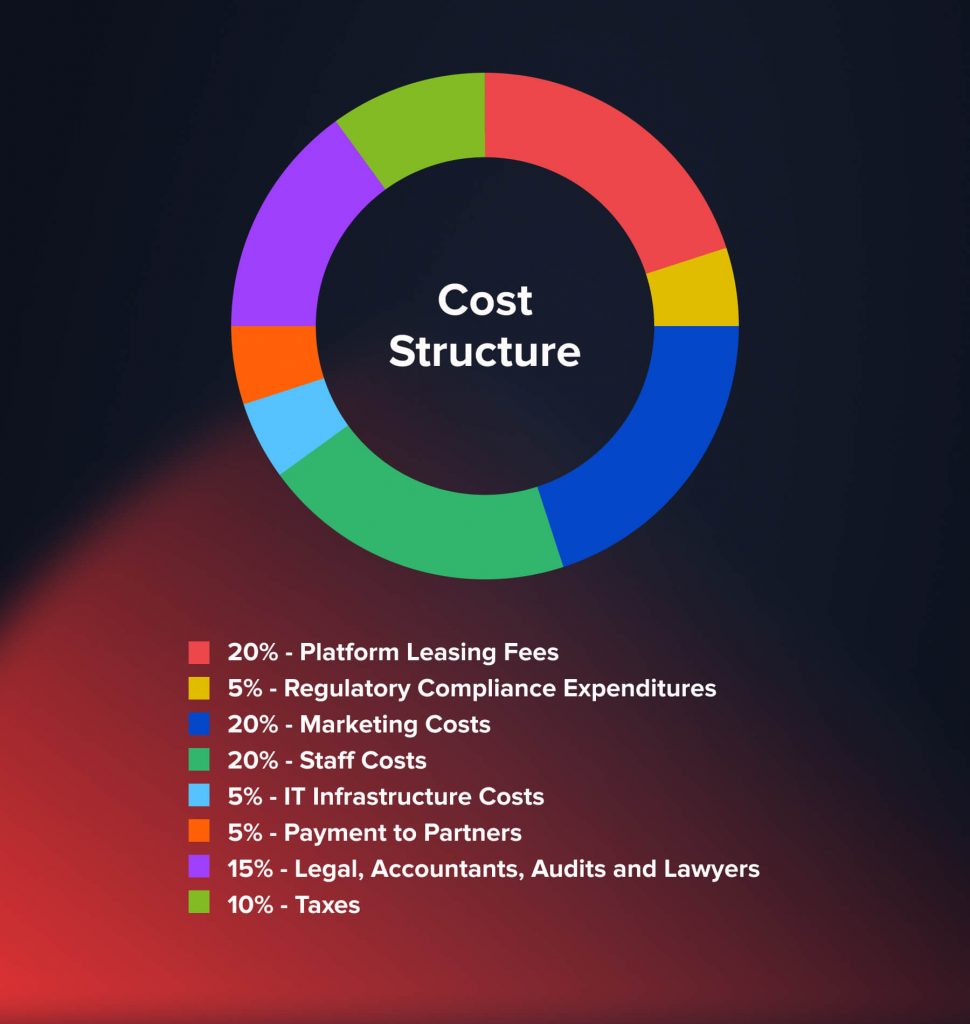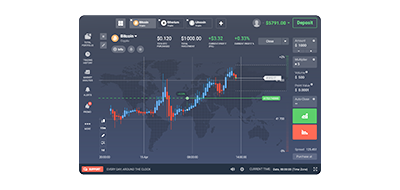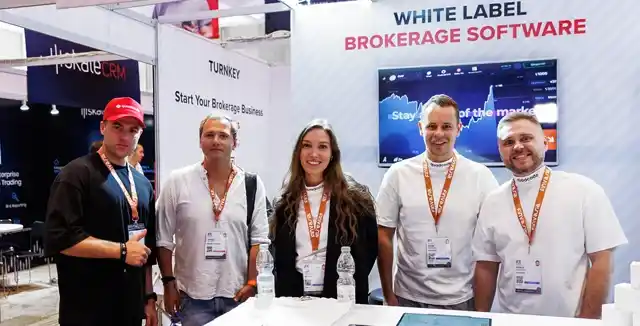Volver
Contents
How To Start a White Label Prop Trading Firm? — Ultimate Guide

White Label

Vitaly Makarenko
Chief Commercial Officer

Demetris Makrides
Senior Business Development Manager
Prop trading is financial firms or traders using their own money to trade rather than receiving fees from client trades like conventional brokerages do. Unlike in brokerage models, in prop trading traders aim for direct market profits through acquiring distinct market positions, not for client trading facilitation. This detailed guide sheds light on the critical aspects of prop trading firm and outlines the practical steps to kickstart such a venture.
How to Start a White Label Prop Trading Platform in 8 Steps
- Understand the regulatory framework
- Acquire the necessary licenses.
- Conduct Research and select the appropriate WL provider
- Negotiate the terms/contract signing
- Customize your platform
- Test the platform
- Conduct performance analysis
- Compliance monitoring
You may also like

How to Start a White Label Prop Trading Firm?
Venturing into White Label Prop Trading requires a well-thought-out approach to ensure success and compliance with various financial regulations. Understanding how to navigate the rough waters of the regulatory landscape is crucian for prospective business owners. Compliance, or the lack of it, strongly reflects on the firm’s reputation and can cost millions of dollars in legal fees. Here’s a more in-depth look into the eight steps needed to embark on this business venture:
1. Understanding Regulatory Framework
It is essential that you are aware of the regulations that govern proprietary trading in the location where you plan to establish a White Label Prop Trading Firm. For instance, it is critical to be acquainted with the regulations established by the Securities and Exchange Commission (SEC) and the Commodity Futures Trading Commission (CFTC) in the United States. You can learn about these regulations from government websites, courses or financial regulation books. Moreover, being a member of various industry organizations can offer deeper understanding of regulations and connect you with peers in the industry.
2. Acquiring Necessary Licenses
After familiarizing yourself with the rules and regulations in place, the following task involves obtaining the required permits and authorizations to run a trading company. The criteria for these permits can differ greatly based on the location and the specific financial products you intend to trade. Securing these permits involves an application process that may involve submitting comprehensive details about your business practices, financial stability and the expertise of crucial staff members. In addition to that, being part of established exchanges might be required to run a trading company, which could grant entry to trading platforms and other essential tools for carrying out trades.
3. Research and Selection
The step towards setting up a White Label Prop Trading Firm heavily relies on partnering with a trustworthy White Label provider. The first step is thorough research to identify a provider with a robust trading platform, a good history, and solid support services. Looking at online reviews, getting suggestions from those in the industry, and exploring the provider’s past partnerships are wise approaches to judging the reliability and effectiveness of potential providers.
Moreover, it is crucial to assess the trading platform’s capacity and user friendliness to guarantee that it satisfies the needs of modern trading operations. Furthermore, evaluating the support services provided by the provider – such as training materials and assistance – is crucial as they help to preserve operational efficiency beyond launch.
4. Negotiating Terms
After choosing the provider the next stage involves discussing the details of the partnership, which includes services offered, expenses incurred and agreements on liability. To prevent any future misunderstandings, a thorough contract should specify duties and obligations for your business as well as for the provider. One must first understand the implications including initial costs, monthly expenses, and any additional payments for extra services. Legal protection of your business and the definition of each party’s degree of obligation in different circumstances depend on liability agreements being in place.
5. Customizing the Trading Platform
The technical setup is a crucial phase in establishing your White Label Prop Trading Firm. It begins with tailoring the trading platform supplied by the White Label provider to resonate with your brand identity and to cater to the particular needs of your clientele. This could encompass modifying the platform’s design elements like logos, color schemes, and user interface to align with your brand’s theme, as well as tweaking its functionality to ensure it serves your clients effectively.
6. Testing
Thorough testing is needed to determine the platform’s performance and dependability once the modification is complete. This testing phase should aim to identify and fix any technical issues or glitches that might hinder smooth trading operations. It’s prudent to simulate actual trading scenarios to check how the platform handles different market conditions and trading volumes. Addressing any shortcomings discovered during testing will ensure your trading platform is robust and ready for launch.
7. Performance Analysis
Running a White Label Proprietary Trading Firm successfully involves striving for improvement and following regulatory guidelines diligently. Start by evaluating the effectiveness of your trading activities. This includes analyzing trading results to spot patterns and recognizing opportunities for enhancement. It’s crucial to grasp what aspects are successful and what areas need attention in order to make better choices that enhance performance.
8. Compliance Monitoring
On the compliance front, it’s paramount to establish a robust monitoring system to ensure your firm continually meets regulatory requirements. This system should help you track adherence to the rules set by financial authorities and alert you to any discrepancies. Moreover, as regulations may evolve, staying updated on any changes in the regulatory landscape is crucial. Ensure you have a process to review new or amended regulations and adjust your compliance procedures accordingly.
This dual focus on continual improvement and vigilant compliance monitoring not only enhances your firm’s operations but also helps build and maintain a reputation of integrity and professionalism in the competitive trading marketplace.
Launching a White Label Prop Trading Firm is a complex yet rewarding endeavor. By diligently navigating through regulations, establishing a solid partnership with a White Label provider, and ensuring operational readiness, aspiring proprietors set a solid foundation for a successful trading enterprise.
Now that we’ve gone over how to set up your very own WL prop trading platform, let’s take a look at prop trading as a whole.
How Much Does it Cost to Start a Prop Trading Firm
Financial management is a cornerstone of success in establishing a White Label Prop Trading Firm. A clear understanding of the cost structure and potential revenue streams not only facilitates better financial planning but also empowers the firm to navigate through the complexities of the trading industry with a solid fiscal strategy.
Cost Structure
The financial foundation of the company is formed by its cost structure, which affects its operational viability as well as expansion possibilities. From platform leasing fees to regulatory compliance expenses, every cost factor is quite important in determining the financial situation of the company. Let’s examine these cost elements more closely to develop an overall knowledge that might guide sustainable development and prudent spending.

- Platform Leasing Fees: Securing access to a reliable trading platform through a White Label provider involves leasing fees which form a significant portion of the initial and ongoing costs.
- Marketing Costs: Building a brand and attracting traders requires a well-thought-out marketing strategy, and the associated costs can be substantial.
- Staff Costs: This encompasses office-related expenses. Competitive salaries are instrumental in recruiting and retaining talent, and a proficient workforce is essential for operating success.
- IT Infrastructure Costs: Maintaining a robust and secure IT infrastructure is imperative for seamless trading operations and data security.
- Payments to Partners: Rewards to Introducing Brokers and other partners are essential for growing your client base and maintaining good relationships.
- Legal, Accountants, Audits, and Lawyers: Ensuring legal compliance and maintaining transparent financial records require professional services that come at a cost.
- Taxes: Like any other business, prop trading firms are subject to taxation, which needs to be factored into the cost structure.
Revenue Streams
The financial vitality of a White Label Prop Trading Firm extends beyond merely the profits derived from trading activities. By carefully identifying and using several revenue sources, the financial situation of the company can be much improved, guaranteeing a consistent flow of income even in the middle of economic uncertainty. The following sources of income enable companies to create a diverse income portfolio capable of navigating financial storms and positioning the company on a road of continuous profitability.
- Commission from Trading Volume: Earning commissions on the trading volume generated by your traders is a direct revenue stream.
- Spread Markups: Marking up spreads can provide additional revenue, though it’s essential to remain competitive not to deter traders.
- Markups on Deposit/Withdrawals via PSPs and Crypto: Implementing markups on financial transactions can generate additional income.
- Currency Exchange Spread & Commission Markup: Profits can be made from currency exchanges and commission markups.
- SWAP Markups: Swap rates can be marked up to generate additional revenue.
- Other Brokerage Revenues: This could encompass a range of other services or fees, such as performance fees, subscription charges for additional services, or revenue-sharing arrangements with the provider.
The Benefits of a White Label Platform
The collaborative nature of the WL Prop Trading Firm model brings about several benefits for the white label firm, predominantly the significant reduction in capital requirements and operational challenges. This model essentially provides a quicker market entry, saving time and resources that would have otherwise been spent on establishing systems from scratch.
The model also allows leveraging the established technological and regulatory infrastructure of the provider, which are significant advantages since technology and compliance are core pillars in trading operations. This access enhances operational efficiency and instills confidence among clients and stakeholders.
Moreover, WL platforms allow for easier scalability and growth. This is crucial for a company that wants to expand and adapt to the market and to the needs of its clients and trader. A WL platform allows the firm to expand the asset classes offered without additional significant investments into the firm’s original infrastructure.
Furthermore, the model fosters a mutually beneficial environment for the provider and the white label operator. The exchange of expertise and resources enhances market penetration and financial success, creating a more prosperous trading environment. This collaboration benefits not only the two entities involved but also their clientele, who will experience better service and trading options.
In essence, the WL Prop Trading Firm model accelerates setting up a trading firm and creates a conducive environment for mutual growth and success in the competitive trading market. Through shared resources and expertise, both the WL provider and the WL operator have the potential to flourish and make significant inroads in the market landscape.
Conclusion
Setting up a White Label Prop Trading Firm involves strategic planning, regulatory guidelines, and operational skills. This business model offers aspiring owners a solid way to dive into prop trading activities with less risk, thanks to the support from the primary firm’s infrastructure. With careful planning, skilled execution, and ongoing learning, aspiring owners are well-placed to navigate the complex world of financial markets and make a notable mark in the proprietary trading field.
Actualizado:
27 de febrero de 2025
12 de marzo de 2025
ES VERSION OF NEW POST FOR TESTING BLOG AND WP
What is Lorem Ipsum? Lorem Ipsum is simply dummy text of the printing and typesetting industry. Lorem Ipsum has been the industry’s standard dummy text ever since the 1500s, when an unknown printer took a galley of type and scrambled it to make a type specimen book. It has survived not only five centuries, but also […]




